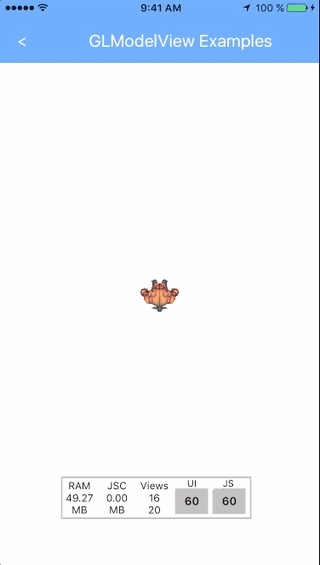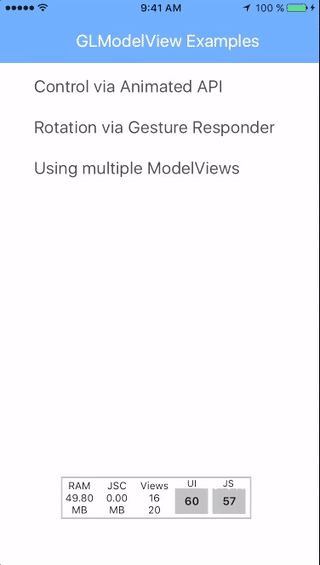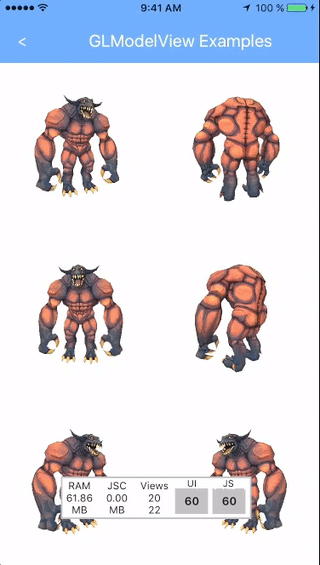react-native-gl-model-view
A <ModelView> component for react-native, allowing you to
display and animate any Wavefront .OBJ 3D object. Realized with a native bridge to GLView for iOS and a native bridge to jPCT-AE for Android.
Main features:
- Display, rotate, scale and translate textured 3D models!
- Animate with blasting fast 60 fps by using the Animated API native driver
- Supports Wavefront .OBJ and GLEssentials model formats (iOS)
- Supports Wavefront .OBJ, Autodesk 3DS, Quake 2 MD2, ASC and GLEssentials model formats (Android)
- Supports all texture image formats supported by UIImage
Getting started
Since React Native 0.60 and higher, autolinking makes the installation process much simpler.
$ yarn add react-native-gl-model-view
# Update your pods (iOS)
$ cd ios
$ pod installUsing React Native Link (React Native 0.59 and lower)
Run react-native link react-native-gl-model-view after which you should be able to use this library on iOS and Android.
iOS Manual installation
$ yarn add react-native-gl-model-view
Afterwards add following lines to your Podfile:
pod 'React', :path => '../node_modules/react-native'
pod 'RNGLModelView', :path => '../node_modules/react-native-gl-model-view'Android Manual installation
$ yarn add react-native-gl-model-view
Afterwards, add the following lines to the android/settings.gradle file:
include ':react-native-gl-model-view'
project(':react-native-gl-model-view').projectDir = new File(rootProject.projectDir, '../node_modules/react-native-gl-model-view/android/app')Finally, add the react-native-gl-model-view project as a dependency of the android/app/build.gradle file:
dependencies {
compile project(':react-native-gl-model-view')
...
}Usage
Model and texture loading
iOS
To load a model on iOS, you need to put the file at the root of your Xcode project via the editor.
Android
To load a model on Android, you need to place the model in the android/app/src/main/assets folder. Create a new folder if it doesn't exist yet.
Static
import ModelView from 'react-native-gl-model-view';
<ModelView
model={{
uri: 'model.obj',
}}
texture={{
uri: 'texture.png',
}}
scale={0.01}
translateZ={-2}
rotateZ={270}
style={{flex: 1}}
/>Animated
Make the <ModelView>'s native props animatable by wrapping the Animated API around it:
import ModelView from 'react-native-gl-model-view';
import { Animated, Easing } from 'react-native';
const AnimatedModelView = Animated.createAnimatedComponent(ModelView);As this usage of the Animated API is kinda hacky, you must call the private __makeNative() method on all Animated.Values before using Animated.multiply and such.
constructor() {
this.state = {
zoom: new Animated.Value(0),
// ...
};
Object.keys(this.state).forEach(key =>
this.state[key] instanceof Animated.Value &&
this.state[key].__makeNative()
);
}Now you can apply all the Animated API magic to the <AnimatedModelView>'s props.
render() {
<AnimatedModelView
...
animate={true}
translateZ={this.state.zoom}
/>
}
componentDidMount() {
Animated.timing(this.state.zoom, {
toValue: -2,
useNativeDriver: true,
duration: 2000,
easing: Easing.bounce
}).start();
}Properties
| Prop | Default | Type | Description |
|---|---|---|---|
| model | undefined | object |
filename or URL of the model as uri |
| texture | undefined | object |
filename or URL of the texture as uri |
| tint | {r: 1.0, g: 1.0, b: 1.0, a: 1.0} | object |
Tints the texture or set the color of the model if there is no texture |
| animate | false | bool |
Model re-renders each 1/60s when set to true |
| flipTexture | false | bool |
The texture will be flipped vertically when set to true |
| scale | 1 | number |
Scale all axes of the model by given factor (overwrites scale*) |
| scaleX | 1 | number |
Scale X axis by given factor |
| scaleY | 1 | number |
Scale Y axis by given factor |
| scaleZ | 1 | number |
Scale Z axis by given factor |
| rotateX | 0 | number |
Rotate around X axis by given degree |
| rotateY | 0 | number |
Rotate around Y axis by given degree |
| rotateZ | 0 | number |
Rotate around Z axis by given degree |
| translateX | 0 | number |
Translate X position by given points |
| translateY | 0 | number |
Translate Y position by given points |
| translateZ | 0 | number |
Translate Z position by given points |
Examples
Check out the example project:
- Usage of the Animated API
- Using the GestureResponder to control rotation
- Animating multiple ModelViews at once
- Using an online model and texture
To install the dependencies, switch into the example folder and set it up as following:
$ yarnTo build and run the app, set it up as following:
iOS
$ cd ios
$ pod install
$ cd ..
$ react-native run-iosAndroid
$ react-native run-androidSpecial thanks
- PatriceVignola for the Android part of this library!
- Cawfree for adapting the library for remote model downloadability
- nicklockwood for his work on GLView
- frostney for his work on react-native-create-library used to bootstrap this project
License
The MIT License (MIT)
Copyright (c) 2019 Michael Straßburger Copyright (c) 2019 The react-native-gl-model-view authors
Permission is hereby granted, free of charge, to any person obtaining a copy of this software and associated documentation files (the "Software"), to deal in the Software without restriction, including without limitation the rights to use, copy, modify, merge, publish, distribute, sublicense, and/or sell copies of the Software, and to permit persons to whom the Software is furnished to do so, subject to the following conditions:
The above copyright notice and this permission notice shall be included in all copies or substantial portions of the Software.
THE SOFTWARE IS PROVIDED "AS IS", WITHOUT WARRANTY OF ANY KIND, EXPRESS OR IMPLIED, INCLUDING BUT NOT LIMITED TO THE WARRANTIES OF MERCHANTABILITY, FITNESS FOR A PARTICULAR PURPOSE AND NONINFRINGEMENT. IN NO EVENT SHALL THE AUTHORS OR COPYRIGHT HOLDERS BE LIABLE FOR ANY CLAIM, DAMAGES OR OTHER LIABILITY, WHETHER IN AN ACTION OF CONTRACT, TORT OR OTHERWISE, ARISING FROM, OUT OF OR IN CONNECTION WITH THE SOFTWARE OR THE USE OR OTHER DEALINGS IN THE SOFTWARE.



